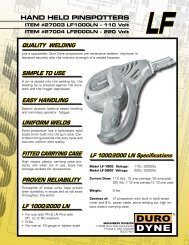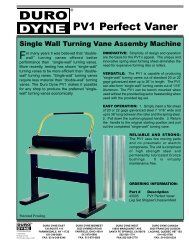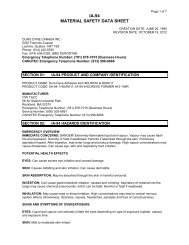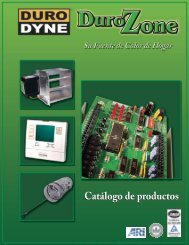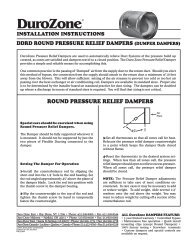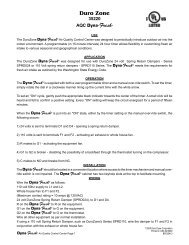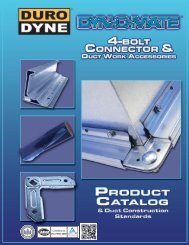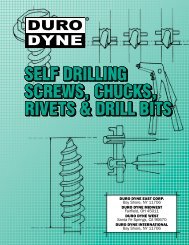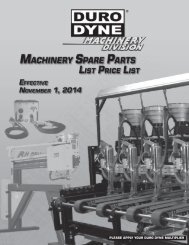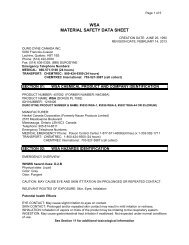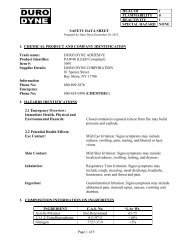You also want an ePaper? Increase the reach of your titles
YUMPU automatically turns print PDFs into web optimized ePapers that Google loves.
Hammer Information and Safety<br />
Nail Hammers<br />
• Face radius and chamfer are designed to provide<br />
a hard striking face.<br />
• Mid-section is resilient yet extra strong.<br />
• Claws are tough, sturdy, edges are beveled, with<br />
uniform taper and bite.<br />
Nail hammers are made in two patterns; curved<br />
claw and ripping (straight) claw. The face is slightly<br />
crowned with the edges beveled, although certain<br />
heavy-duty patterns may have checkered faces<br />
designed to reduce glancing blows and flying nails.<br />
Handles may be wood, solid steel or fiberglass. Solid<br />
steel and fiberglass are generally furnished with rubber-type<br />
grips.<br />
CLAW SIDE<br />
POLE<br />
FACE<br />
CLAW<br />
NECK<br />
BELL<br />
EYE<br />
CURVED CLAW<br />
FACE<br />
CHAMFER<br />
RIGHT SIDE<br />
LEFT SIDE<br />
EYE WALL<br />
RIPPING CLAW<br />
TIP<br />
SPLIT<br />
Handles<br />
For many good reasons, the traditional choice of<br />
material for a striking tool handles is North American<br />
Red Hickory. It looks good and it naturally feels<br />
good. The continuous fibers of this fine stock give<br />
great resilience and strength while minimizing impact<br />
shock. But man made materials have their advantages<br />
too. Fiberglass can’t rust, rot or corrode, and<br />
despite its light weight, it has astonishing strength.<br />
Tests on a Tinius-Olsen testing machine have shown<br />
that with more than 450 lbs. of applied load, a fiberglass<br />
handle won’t break. The latest material, used<br />
in hammers, is solid steel. The head will never come<br />
off and the hammer is well balanced to give extra<br />
power with less fatigue.<br />
Schematic diagram of flexural<br />
strength test. Note that load is<br />
applied to tool handle in the<br />
same manner as it would be<br />
applied by a user in withdrawing<br />
a nail.<br />
RESTRAINING<br />
PIN<br />
RESTRAINING<br />
BLOCK<br />
APPLIED LOAD<br />
OR FORCE<br />
Safety Tips<br />
Nail Hammers and Hatchets are for driving and pulling common nails. Ball Pein Hammers are intended to<br />
drive against the softer head of a chisel and for general machinists’ use. Any face can be made to chip<br />
if struck against another striking tool or hard surface. This will damage the tool, possibly resulting in eye or<br />
other injury. Replace immediately if chipping or mushrooming occurs.<br />
Hand tools are made in various types and sizes, degrees of hardness and different configurations for specific<br />
purposes. They should be carefully selected and used only for their intended purpose. Proper use of<br />
most types involve certain basic rules.<br />
• Protect your eyes - always wear safety goggles.<br />
• Strike squarely - avoid glancing blows.<br />
• Always use a tool of suitable size and weight for the job.<br />
• The striking face of a hammer should be approximately 3/8" larger in diameter than the struck face of<br />
a chisel, punch, etc.<br />
• Replace immediately upon chipping or mushrooming.<br />
• Never use a tool with a loose or damaged handle.<br />
• Never use a grinding wheel for redressing a cutting edge or a struck face - use a file or whetstone -<br />
redress to original shape and contour.<br />
• Never use a hammer of maul or axe to strike another hammer or maul or axe.<br />
• Never redress a striking face.<br />
• Never use a tool with a dull cutting edge.<br />
35



